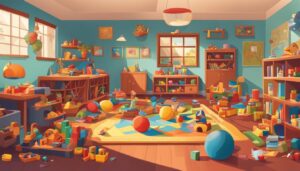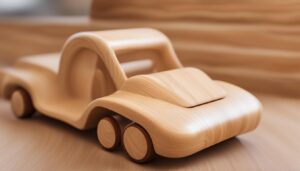Wooden toys make for fantastic heirlooms and can be passed down several generations. If you want to know more about these fascinating objects, you are at the right place. Here, we have collated some interesting facts about wooden toys.
Wooden toys are now becoming more popular than ever. They are charming, simple and sophisticated. They are beloved by children because they are beautiful and aesthetically appealing. Simply adding a wooden toy to your home will help lift its aesthetic appeal and feel.
Wooden toys are super versatile. When it comes to plastic toys, there is always a purpose to the play. With wooden toys, it is a blank canvas. Each child can play with them in their own unique way.
By Renuka.
Wooden toys history
Wooden toys lineage
You would be blown away to know that wooden toys have been around for thousands of years! Yes, the toys have been around since the times of the Romans, Egyptians and Greeks. The tops, dolls, dice, animals and chariots you see today are similar to the toys children used to play with back then.
Rattles and spinning tops
Just like infants of today, people used rattles back then. These rattles formed part of early childhood even 3000 years back. Archaeologists have found wooden rattles filled with pebbles that are over 3000 years old.
Ancient spinning tops, rattles and other playthings were made of wood, ceramics and bone as uncovered by archaeologists.
Researchers discovered an image of an ancient greek wooden toy horse with wheels. This dates back to 950-900 BC. It is fascinating that the pull-along toys of today take after toys of eras past.
A terracotta horse on wheels was discovered in the Kerameikos, the potters’ quarter of the ancient city of Athens in a grave, dating to around 900 BCE.
German toy manufacturers started to make toys made of wood in the 1700s. These wooden toys were detailed and intricate such as wooden dollhouses, the ever-popular jack in the box, and miniature buildings. They began to travel all over Europe to sell their products.
During the 18th century, wooden alphabet blocks were invented in England.
Alphabet blocks are a somewhat more recent invention, which were generally first conceptualized in 16th and 17th centuries, thanks to English philosopher John Locke who is closely associated with ideating the wooden block,
This period also saw the advent of carved miniature wooden animals. Later on, wooden cars and fire engines for kids became more popular.
The 19th century saw the emergence of factory-made toys widely available to the public. The toys that were the rage during this time were toy soldiers, rocking horses, doll houses, wooden train sets, puzzles etc.
The 20th century saw wooden toys become popular in America with the introduction of wooden construction toys. Charles H. Pajeau and Robert Petit founded Tinker toys.
The brand promoted spokes, sticks, spools and rods to construct buildings, animals, vehicles and more.
What wood goes into making wooden toys?
Most wooden toy companies make wooden toys with hardwood. Some of the hardwood used to make toys include:
- Beech
- Birch
- Alder
- Rubberwood
- Oak
- Maple
- Walnut
It is denser, much more durable and challenging to cut. Softwood, on the other hand, is less dense, less durable and far easier to cut.
Some of the softwood used to make toys include:
- Pine
- Cedar
- Basswood
Role of wooden toys in childhood development and educational
Wooden toys are fantastic educational tools
Wooden toys are fantastic educational aids apart from being fun to play with.
According to studies, when children play with natural materials such as wood, it helps in the development of mental capacity along with emotional and physical growth.
Learning from wooden toys
For instance, wooden toys such as building blocks can help children with their literacy and numerical skills.
It also allows them to grasp scientific concepts like balance, gravity, object permanence and cause and effect.
Children can also learn colors, compare the sizes of the different objects and learn small and big, the shape of the various objects, light versus heavy etc.
How wooden toys were conceptualized as educational aids
John Locke, the philosopher, propounded that children should not be prohibited from being children and playing.
He first brought the concept of educational toys to the forefront and laid down the advantages of kids playing with educational wooden toys such as dice and letters to motivate early literacy.
In 1811, Richard Lovell Edgeworth termed wooden blocks as rational toys that could teach kids about gravity and physics.
In 1837, Friedrich Froebel, the inventor of Kindergarten, furnished what was called Froebel Gifts. Froebel was especially interested in the development of toys for children- “gifts” devised to stimulate learning through play.
These were nothing but wooden play materials such as wooden blocks, a wooden sphere, a cylinder and a soft colorful woolen ball developed for hands-on learning for children so that they become more aware and knowledgeable of the world around them.
Now, these were considered some of the best educational tools for toddlers and preschoolers for ages.
Wooden toys help children focus and concentrate
Wooden toys help children concentrate better.
This is because playing with wood stimulates the senses and has a calming effect on kids.
When people work in an environment with natural lighting and solid wood items, it helps put their minds and bodies at ease, and balance their thoughts and focus better.
Did you know children can learn better in creative spaces with wood elements?
According to a study by the National Institutes of Health in 2017, contact with wood induces physiological relaxation.
A quiet and relaxing play environment with natural elements like wooden toys stimulates concentration, aids in cognitive development and enhances problem-solving ability. It provides children with hours of fun, learning, sensory experience, and overall development.
Conclusion
Wooden toys are timeless, and beautiful and offer endless hours of fun and imaginative play.
They are eco-friendly, durable and can be passed on to generations.
They offer lots of possibilities for learning and early childhood learning and development.
Without a doubt, wooden toys are some of the best toys to play with!
Photo by cottonbro.




